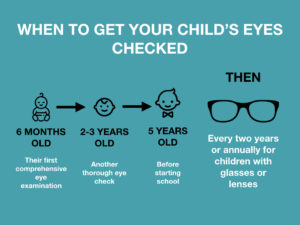Your guide to kids vision

As a parent, you want to make sure your children are happy, healthy and developing in the best way possible. Being educated about their health is one of the best ways you can support them, and eye health is no exception!
To help you care for your little one’s eyes, we’ve put together a helpful guide to kids vision, covering eye development, symptoms to look out for, and everyday eye protection.
Keeping an “eye” on early development
 Did you know? In just the first 6 months of a child’s life, the majority of their eye development will take place? This includes growth, eye coordination, tracking, focus, and facial recognition.
Did you know? In just the first 6 months of a child’s life, the majority of their eye development will take place? This includes growth, eye coordination, tracking, focus, and facial recognition.
Because children’s visual abilities continue to develop throughout childhood, it is important to keep an eye on children’s vision development up to and beyond school age.
Here are some things to consider when monitoring your young child’s vision and eye development:
- Sharpness and Fixation: can your child see small details at close, middle and/or far distances? If an eye turns in or out an evaluation is warranted.
- Eye Coordination: can they follow a moving object and grasp it? Encourage crawling which helps further develop eye-hand-foot-body co-ordination
- Focus: does your child appear to be able to focus on an object or image clearly? Are they interested in looking at pictures or books for a normal length of time?
- Visual Integration: does your child see something and appear to process what it is? For example, do they recognise faces? We have to learn how to use the visual information in order to understand the world around us and to interact with it appropriately.
What symptoms should you be looking for?
 One of the most common problems we see with children’s vision is poor control of near focus – or as we call it accommodation and convergence dysfunction.
One of the most common problems we see with children’s vision is poor control of near focus – or as we call it accommodation and convergence dysfunction.
This can affect their learning, so it’s important to try and spot any possible vision issues when they arise.
Here are some symptoms that might indicate if a child has poor accommodation or convergence ability.
- Dislike of close work (reading, writing, etc.)
- Awkward, uncomfortable posture or tilting of head
- Excessive blinking or rubbing eyes
- Closing one eye or losing their place when reading
- Headaches, rapid fatigue, dizziness or nausea
- Sitting close to the TV or school board
If your child is showing these symptoms, don’t worry – there are solutions! More often than not this problem can be easily diagnosed with an eye test. Solutions could include vision therapy or prescription glasses. If you notice any of these symptoms in your child please book them in for a eye check up.
Did you know? The Government offers a ‘spectacles subsidy’ for children up to 15 years old with vision problems. The subsidy is available to families with a community services card. Click here to learn more, or contact us if want to know if you’re eligible.
Caring for and protecting your child’s vision
Alongside a healthy diet and lifestyle, there are a few extra things you can do to properly care for your child’s eyes.
Computer screen protection
 In this day and age, technology is ever-increasing and it is being introduced into our children’s lives more and more.
In this day and age, technology is ever-increasing and it is being introduced into our children’s lives more and more.
Many children use screens on a daily basis (both at school and at home), and this can have an impact on their vision.
Too much screen time on a computer, tablet or phone screen can lead to our little ones having headaches, fatigue, discomfort, dry eyes, or worse case scenario, blurred vision and eye strain.
A wide range of studies in children and adolescents are showing that increased recreational screen time is leading to lower physical activity, excessive sitting and increased time spent indoors. Among other things, this is resulting in a decrease in motor skills, higher levels of myopia, increased risk of type 2 diabetes and hypertension.
Here are some tips to help you monitor kids screen time:
- Limit total screen time: we recommend limiting screen time to zero for kids under 2’s, maximum 1 hour per day for 2-4 year old’s and 2 hours a day for 5-17 year olds.
- Breaks: encourage your children to take ten minute breaks for every half hour of screen time.
- Encourage outdoor activity: One of the risk factors for the development of myopia or short sightedness in children is spending less than 1.5 hours per day outdoors. Encouraging outdoor activity should be easy with younger kids but can become more challenging the older they get.
- Computer position: children should be looking down on to a screen rather than up
- Lighting: adjust the lighting and ensure there is no sunshine glare on the screen
Regular eye examinations
Children should be taken to the GP, Plunket nurse or Optometrist for regular eye exams from 6 months of age and up.
It’s very important for children to get a thorough eye examination before they start school. A proper eye exam can identify and address vision problems that could affect their learning before it becomes a major issue.

So, to ensure your child has equal opportunities for learning growth and development, please book them in for a check up before they start school this year, and regular checks from here on out!
If you would like to purchase some children’s sunglasses, are concerned about your child’s eyes, or they haven’t had a check up in a while, please phone us on 5251516 or pop in to book an appointment.
Featured Posts
Christmas made easy
by Jenny Greenlane Penrose Optometrist Christmas gift ideas Give the gift of perfect sight Starting from $15, you can keep your glasses secure in style. This handbag doubles as a glasses case! An over-the shoulder-handbag made with...
Our recommended treatment for blepharitis
by Jenny Let us help you fight blepharitis At Greenlane Penrose Optometrist we, stock SteriLid Foaming Eyelid Cleanser and Systane Lid Wipes, as both have been proven effective in managing blepharitis. SteriLid is a super easy-to-use...
Address
Cnr Great South Road & Rockfield Road, Greenlane 1051
Phone
09 525 1516
Hours
Mon to Fri: 9am – 5pm
Sat to Sun: Closed
Holidays: Closed


